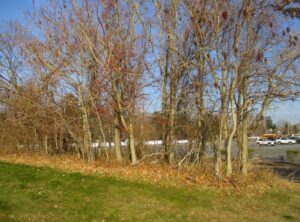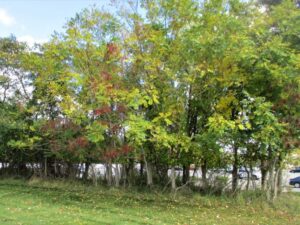This post covers three topics:
- Control and timing of applications for Red-headed flea beetle (RHFB) – Systemic materials should be used now to target emerging adults in May.
- Please refer to this resource for timing and material selection: RHFB timeline using GDD, material selection, print-out ready (click here)
- Combination of resources from Danny Lauderdale (NC State), Brian Kunkel (UDel.), Tim Waller (RU)
- Seasonal reminders:
- Protectant, broad-spectrum ‘cover-sprays’ should be initiated ASAP or as plastic is removed / crops can be accessed
- SLF egg masses: We are all in this together should be remembered when it comes to checking loads for SLF.
- Pest Scouting for 100-200 Growing Degree-days (approx. next two weeks in Southern and Central NJ).
Growing degree-days as 4/12/22 (~Next two weeks)
| Projected GDD50 accumulation as of 4/13/2022 | Note: Growing degree-day values utilize daily average air temperatures with a minimum temperature threshold (a.k.a. ‘base’) of 50F = GDD50 (max. temp. threshold set at 95F). These values are accumulated from a biofix date, such as January or March 1st in the NE USA. Provided GDD50 are scouting ranges and should be truthed. | |||||
| Region | Location | Station | 13-Apr | 1-May | 1-Jun | |
| South | Upper Deerfield | NJ50 | 116 | 236 | 660 | |
| Central | Howell / Freehold | NJ10 | 114 | 200 | 553 | |
| North | High Point | NJ59 | 35 | 67 | 313 | |
| Forecast: NOAA NCEP Coupled Forecast System model version 2 (CFSv2) forecast system (3.5 months) (USPEST.ORG) | ||||||
| Crop type | Common Name | Scientific Name | GDD Min (50F) | GDD Max (95F) | Reference | Developmental / Target Stage |
| Conifer | Pine engraver (Ips bark beetle) | Ips spp. | 100 | 150 | 4 | 1st adults active |
| Conifer | Balsam twig aphid | Mindarus abietinus | 100 | 150 | 4 | Stem mothers present (control target) |
| Conifer | European pine sawfly | Neodiprion sertifer | 100 | 195 | 4 | 1st larvae active |
| Andromeda | Andromeda lace bug | Stephanitis takeyai | 115 | 279 | RU | Nymphs (1st generation) |
| Azalea | Azalea lace bug | Stephanitis pyrioides | 118 | 372 | RU | Nymphs (1st generation) |
| Conifer | Larch casebearer | Coleophora laricella | 120 | 150 | 4 | Egg hatch |
| Elm, Service berry | Woolly elm aphid | Eriosoma americana | 121 | 246 | 2 (6) | Control target |
| Birch | Birch leafminer | Fenusa pusilla | 123 | 290 | RU | Adults – egg laying |
| Many | Gypsy moth | Lymantria dispar | 145 | 200 | 4 | Egg hatch, 1st larvae |
| Holly | Holly leaf miner | Phytomyza ilicis | 147 | 265 | RU | Adults – egg laying |
| Many | Cankerworms, inch-worms, loopers | (many) | 148 | 290 | 2 | Larvae treatment |
| Yews, Rhododendrons, many | Black Vine Weevil | Otiorhynchus sulcatus | 148 | 400 | 2 | Pupation / Adult emergence |
| Lilac, ash, privet, many | Lilac / Ash Borer | Podosesia syringae | 148 | 299 | 2 | Adult flight |
| Dogwood, many | Dogwood Borer | Synanthedon scitula | 148 | 700 | 2 | Adult activity |
| Conifer | Hemlock woolly adelgid | Adelges tsugae | 150 | 150 | RU | Eggs and 10% hatch |
| Conifer | Spruce needleminer | Endothenia albolineana | 150 | 200 | 4 | 1st larvae active |
| Conifer | Spruce spider mite | Oligonychus ununguis | 150 | 175 | 4 | 1st egg hatch |
| Conifer | Balsam gall midge | Paradiplosis tumifex | 150 | 300 | 4 | Adults laying eggs |
| Witchhazel, River birch | Spiny witchhazel gall aphid | Hamamelistes spinosus | 171 | – | 6 | Control target |
| Birch | Birch Leafminer | Fenusa pusilla | 175 | 215 | 4 | 1st adults active |
| Birch | Birch leafminer | Fenusa pusilla | 190 | 290 | RU | Larvae (1st generation) |
| Conifer | Spruce spider mite | Oligonychus ununguis | 190 | 363 | RU | Immatures/Adults |
| Rhododendron | Rhododendron gall midge | Clinodiplosis rhododendri | 192 | 363 | RU | Larvae |
| Honeylocust | Honeylocust pod gall midge | Dasineura gleditchiae | 192 | 229 | RU | Larvae |
| Privet | Privet thrips | Dendrothrips ornatus | 192 | 618 | 2 | Typical treatment window |
| Holly | *Native holly leafminer | Phytomyza ilicicola | 192 | 298 | 2 | Egg hatch |
| Holly | Holly leafminer | Phytomyza ilicis | 192 | 290 | RU | Egg hatch |
| Willows, Cottonwood, Poplar | Imported willow leaf beetle | Plagiodera versicolora | 192 | 448 | RU | Larvae/Adults |
| Larch | Larch sawfly | Pristophora erichsonii | 192 | 299 | 2 | Typical treatment window |
| Andromeda | Andromeda lacebug | Stephanitis takeyai | 192 | 303 | RU | Adults |
| Rhododendron | Rhododendron borer | Synanthedon rhododendri | 192 | 298 | 2 | Typical treatment window |
| Conifer | Cooley spruce gall adelgid | Adelges cooleyi | 200 | 310 | 4 | 1st galls visible – Spruce |
| Spruce | Spruce budworm | Choristoneura fumiferana | 200 | 300 | 5 | Larvae |
| Conifer | Douglas fir needle midge | Contarinia pseudotsugae | 200 | 400 | 3 | Adults emerge from soil |
| Lilac, ash, privet, many | Lilac / Ash Borer | Podosesia syringae | 200 | 299 | RU | Adults – 1st Treatment |
| References | RU | Rutgers Cooperative Extension – Landscape IPM Notes | ||||
| Daily GDD50 = (Max + Min temp.) / 2 – 50 (min temp. threshold) (Simple average growing degree-day, min. 50F, max 95F) | 2 | http://ccetompkins.org/resources/using-growing-degree-days-for-insect-management | ||||
| 3 | https://extension.psu.edu/ipm-basics-for-christmas-trees#section-2 | |||||
| 4 | https://www.canr.msu.edu/ipm/agriculture/christmas_trees/gdd_of_conifer_insects | |||||
| 5 | https://www.agriculture.nh.gov/publications-forms/documents/landscape-pests.pdf | |||||
| 6 | https://extension.umd.edu/ipm/pest-predictive-calendar-landscapenursery | |||||
| 7 | https://www.canr.msu.edu/ipm/agriculture/christmas_trees/gdd_of_landscape_insects | |||||
| Unv. Del. | Coorespondance with Dr. Kunkel (University of Delaware)-evolving GDD ranges | |||||
| Compiled by – Timothy J. Waller, Ph.D. – Rutgers Cooperative Extension, Cumberland County Nursery Crops – twaller@njaes.rutgers.edu | ||||||
Please Download these resources: (The scouting guide is for you to print and keep on hand…these are just updates)
Nursery and Landscape Pest Scouting Guide 2022 PDF (note this contains conifer pests as well)
Conifer Pest Scouting Guide 2022 PDF
Contact if seeing insects at different times: twaller@njaes.rutgers.edu (or call the Cumberland County Extension Office – 856-451-2800)


